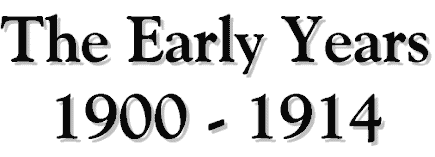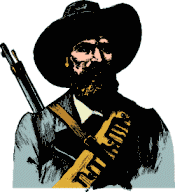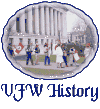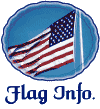![]()

 As could be expected, the new century started off with much activity. In the
United States, the Spanish American War veterans worked on building harmony, not discord.
In the space of thirteen years, the American Veterans of Foreign Service, the Colorado
Society Army of the Philippines, and three newer veteran's organizations would all resolve
their differences and merge into one association. United under the name of the Veterans of
Foreign Wars of the United States, these veterans would go on to jointly pursue their
dream of better treatment of all American veterans. As could be expected, the new century started off with much activity. In the
United States, the Spanish American War veterans worked on building harmony, not discord.
In the space of thirteen years, the American Veterans of Foreign Service, the Colorado
Society Army of the Philippines, and three newer veteran's organizations would all resolve
their differences and merge into one association. United under the name of the Veterans of
Foreign Wars of the United States, these veterans would go on to jointly pursue their
dream of better treatment of all American veterans.The watchword in the creation of the VFW was one sorely lacking in European politics of the day - compromise. Before the major reorganization of five veteran's organizations into one could take place, several minor mergers and changes in organizational structure had to occur. Thousands of members of the existing organizations also had to concede that one large national organization could serve their interests better than the more specialized, but smaller ones to which they already belonged. The East From the first meeting of the American Veterans of Foreign Service, it was evident that its founders had far more than a local society in mind. But although their enthusiasm and aspirations were great, their planning often did not keep pace with their ideas. It took the pragmatism of Jim Romanis to turn the ideas into reality. Several weeks before the encampment of 1904, Romanis persuaded a group of Spanish American War veterans based in Pennsylvania to send a representative to the AVFS's encampment. This veterans group, which was coincidentally also known as the American Veterans of Foreign Service, had responded by sending their National Junior Vice Commander, Dr. George Metzger. When he appeared before the assembled delegates in Columbus, Metzger made an unexpected proposal. He suggested that the Columbus officers attend his group's National Encampment the following week in Allegheny, Pennsylvania, for the purpose of discussing a possible merger of the two veteran's groups. Without hesitation, the delegates voted to send their President, James Romanis, and empowered him to take any action he felt necessary to expedite the merger. The merger eventually happened in 1905. After the 1905 merger, it was quite some time before the AVFS once again made headlines. From 1905 to 1908, the organization worked mainly on structuring and consolidating this newly merged, larger group. The group grew both in political power membership. In 1910 an AVFS membership report showed thirty-four posts in good standing with approximately 1,200 members. The West General Irving Hale, president of the infant Colorado Society Army of the Philippines, dreamed of building a national veteran's organization that would rival the FAR in size and power. This was a dream he shared with Jim Romanis, cofounder of the American Veterans of Foreign Service. But unlike his Eastern Counterpart, whose dream was clouded only by minor procedural problems in getting his organization up and running, Hale needed to overcome two major obstacles - one natural, one man-made - that stood in the way of his goal. Geographical factors presented the first stumbling block to growth of the Army of the Philippines. The East had many more towns large enough to support a camp, and veterans who lived outside of town had less distance to travel to camp meetings. To complicate matters, cowboys, sheep herders, and men who worked in the mining camps out west were continually moving about. The second hindrance to recruitment of new members was one that the Army of the Philippines had imposed on itself: its restriction of membership to men who had served in one theater of one war. Thanks to Hale's outreach efforts, almost one thousand Philippine veterans, representing nineteen military units of the Eighth Army, attended the reunion in Denver on August 13, 1900. They came from Colorado, Utah, Oregon, Iowa, Nebraska, the Dakotas, and all of the western states. In the business session, a constitution and bylaws were swiftly adopted for the national body. So too was a name for the organization: "The National Association of the Army of the Philippines." Although General Hale was the most popular and logical candidate to head the national association, he was not elected as president. Instead the honor went to General Francis V. Greene of New York City. Historians believe he was elected to help attract more veterans from the East as members. Even with an Easterner at its helm, the Society found its recruiting efforts hampered by the requirement that members must have served in the Philippines. Many attempts were made to merge with other veterans organizations, but up till now, all were voted down. At the 1912 reunion in Lincoln, Nebraska, several representatives from the AVFS who were in attendance suggested a merger of the two organizations. The Army of the Philippines promptly invited these members to attend the next year's reunion in Denver to discuss the possibility further. In fact, the entire AVFS National Encampment would end up meeting with the Army of the Philippines in Denver, thanks to the scheming of one man. That man, Gus Hartung, was the commander of the Denver-based John S. Stewart Camp of the Army of the Philippines. During the 1912 reunion, he proposed that the next reunion of the Army of the Philippines be held in Denver, and the delegates agreed. After the possibility of a merger was raised, Hartung contacted Robert Woodside, Commander-in-Chief of the AVFS and suggested that the AVFS, too, hold its next convention in Denver. When Woodside accepted, the way was paved for the joint meeting of 1913. The convention opened with both groups meeting separately. Each group had a certain amount of old business to handle, and undoubtedly wanted to discuss in private what they would and would not concede in a merger. While rivalry between the groups arose in part from local pride in their unit's "feats of arms," the main dissension came over choosing a name for the new group. Because of the heated discussions and lingering resentment over issues that had passed despite objections from substantial minorities, the delegates postponed most organizational changes to a later meeting or left them to the newly elected officers to make. One major change, however, was silently approved when the Army of the Philippines agreed to merge. It was also decided that the new association would go by the name of "Army of the Philippines, Cuba and Puerto Rico" until a referendum could be held and a name be chosen by a vote of all members and all posts. Henceforth, membership in both groups would be open not just to veterans of the Philippine Campaign, but to veterans who served honorably in any war on foreign soil. There were many who were not satisfied with the merger. In many camps, the legality of the merger topped the list of the most discussed items. In an attempt to take charge of the situation, on September 12, 1913, Commander-in-Chief Rice Means issued General Order Number One. In it, Means appealed to the members' loyalty and patriotism in asking them to set aside their dissatisfaction with the merger. He also announced that local units would henceforth be known as "posts" rather than "camps." Several camps on both sides of the Mississippi continued to protest the merger. In February 1914, Commander-in-Chief Rice Means sent all posts a message suggesting that they agree on a name that was so comprehensive that every veteran would realize that this new organization was not like any other previous veteran's organizations. This one would not die out with the founding generation, but would be available to veterans as long as the United States was forced to fight wars. Official approval of the selected name was later given at the 1914 Convention in Pittsburgh. This approval, coupled with the adoption of the constitution, made that convention the first annual convention of the Veterans of Foreign Wars of the United States. |









 E-Mail
E-Mail